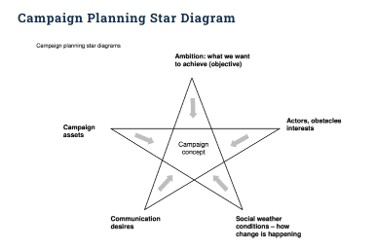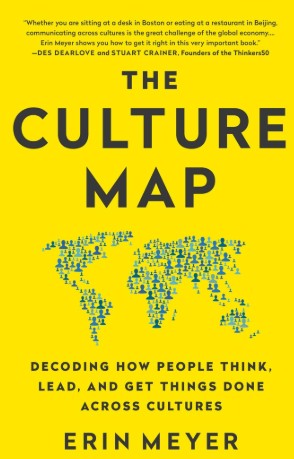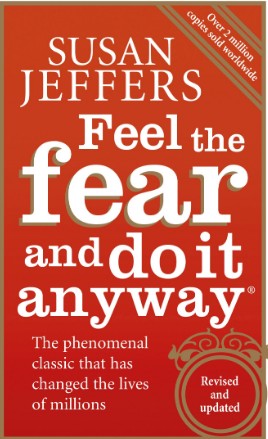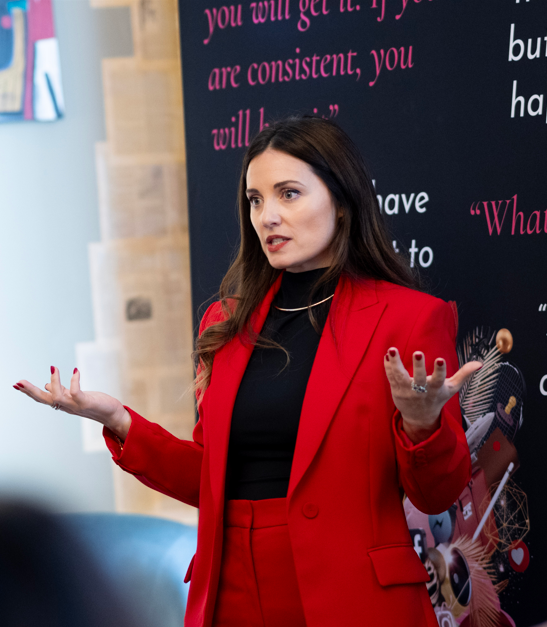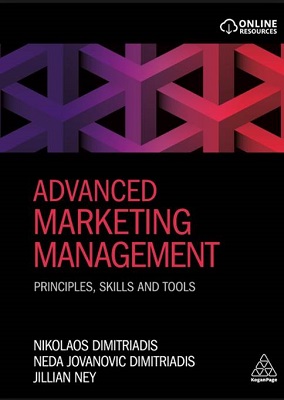
I read and review a lot of books but this was one – Advanced Marketing Management: Principles, skills and tools by Nikolaos Dimitriadis, Neda Jovanovic Dimitriadis and Jillian Ney – is one of the best I have come across for a while. I have sung its praises to many people already. It offers insight and substance into what we can expect from marketing management in the future. The book is timely, persuasive and exciting. It is hard to do the book justice in a short review. It also gives centre stage to two subjects close to my heart – psychology and innovation. And it provides a long-overdue upgrade to the classic 4Ps of marketing.
The authors start by exploring the discrepancy between the status of marketers and the status of marketing – The Marketing Paradox. They put this down to a lack of repeatability and trust. It’s a gentle but interesting start – trotting around some of the great anecdotes from the history of marketing. And then it changes pace. Dramatically.
Neuroscience
The neuroscience section argues traditional methods of customer research are flawed as they are based on reflection and self-reporting and there is a disconnection between brain reactions and conscious understanding. This is followed by a startling list of “brain facts for advanced marketers” and insights into the emotion economy and neurotechnology (e.g. EEG, fMRI, eye tracking, emotional facial and voice recognition, biometrics, implicit response tests).
Predictive skills
Marketing and data intelligence are tackled next. There’s a fascinating case study of Cambridge Analytica’s use of psychographic segmentation (personality traits from digital footprints) in political campaigning. The attention economy (Davenport and Beck, 2010) is addressed next and marketers are told to have a robust insight-driven marketing strategy. The 4 Vs (volume, variety, velocity and veracity) of big data and “content shock” are explored next. I wasn’t reassured that we are now believed to be at peak data complexity (Goodwin, 2016).
There are excellent examples of AI and an exploration of social listening technologies and behavioural metrics. The 12 principles of data ethics from Accenture (2016) are explored as well as the Market Research Society’s 10 principles in its code of conduct.
Innovation skills
This section starts with the relationship between innovation and client loyalty. Unsurprisingly, there is research evidence about the importance of creativity (at the personal, team, organisational and market level) and problem-solving skills amongst marketers. I enjoyed the four horsemen of the apocalypse that kill creativity (meetings, presentations, e-mails and spreadsheets).
Creativity roles and processes and then innovation engines and customer innovation are explored. Google’s 9 innovation principles are set out. Psychology features here too with the importance of frustration in boosting innovation, the four types of breakthrough ideas and blind spots and cognitive bias.
Adaptability skills
Instantly changing products, the co-creation process during the delivery of services, constant updates, disorder, complexity and uncertainty set the scene for this section. “To change your strategy, first change how you think” (HBR, 2017) shows the importance of mental models. Dweck’s growth (support) and fixed (star) mind set model is explored and the success factors for overachieving marketers were found to be a) constantly striving and b) constantly experimenting.
There’s more neuroscience with approach (opportunities) and avoidance (problem) mechanisms and the six dimensions that determine the way the brain reacts emotionally to situations (resilience, outlook, social intuition, sensitivity-to-context and attention) and the power of a positive outlook and self-motivation.
The authors argue that foxes (know many things) are more accurate forecasters than hedgehogs (know one big thing) – which supports the idea that marketers must move from being functional specialists to holistic leaders.
You are shown how to evaluate your decision effectiveness by considering: quality, speed, yield and effort. There’s more psychology in the seven sub-selves that co-exist within humans. Chip and Dan Heath’s decision making framework (process, obstacles and solutions) is reviewed. With warnings about short-termism, there’s a vote for scenario analysis as too often companies only look at one option in their decision making. Irrationality in decision making – particularly Danie Kahneman’s book on “Thinking, Fast and Slow” and Malcolm Gladwell’s “Blink” are covered in the context of our VUCA (Volatility, Uncertainty, Complexity and Ambiguity) world.
Adaptability is one of the six core elements in my book Better Business Relationships
The 4EPs
At page 171, the focus shifts from skills to process. The first part concerns the empathic product and experiential price. The SAVE model for B2B markets (Solutions – Access – Value – Education) is used as an opening position. Empathy is the key word for product – an issue for the one in five CEOs who are psychopaths and the overall drop in empathy levels in society over the past 30 years. And here it links to design thinking (from IDEO). The price material reflects that twice Nobel Prizes in Economics went to psychologists. There’s lots more on the psychology of price.
The second part looks at ever-present place and engaging promotion. The distinction between physical and digital has gone. Peer-to-peer influencing and the evolution of promotional activity from traditional to digital to engaging is explored with the impact of increasing consumer power. The authors consider the seven principles of herd marketing and the six principles of STEPPS method.
Reorganising the marketing function
Most of this material relates to consumer oriented marketing functions. The good news, according to McKinsey research, is that demand for marketers will continue to grow. The need for “technicalisation” is matched by that for better high-level strategic marketers. See the Future of Work report.
Various team structures are explored and the message is that a more circular and networked structure rather than linear structures will prevail. The ideas around holocracy (self-organising “teal” teams) and dual organisational systems (stable operational and flexible innovations) paint an exciting future vision.
The final section is on marketers being the new transformational leaders draws it all together advocating four steps: the marketing paradox, strategic skills, the new marketing mix and the new marketing function. Marketers are positioned as connectors and collaborators. And for PSF marketers, there’s reassuring support for the 1991 relationship marketing model of Christopher, Payne and Ballentyne which we all know and love.
The authors have taken pains to provide detailed evidence and references to just about every point they make – so it’s a fine text book. But this does make it a hard read at times as the information content is so intense. For those in teaching roles, there are also online resources available. There’s a long list of companies included in the book and even a few PSFs (Accenture, Deloitte, KPMG, McKinsey, PricewaterhouseCoopers, WPP).
There’s a lot that – being consumer oriented – doesn’t apply to professional services. But it is important that we understand where the B2C market is going – as we can be that B2B will follow. The authors provide a somewhat daunting but nevertheless exciting future vision of the marketing profession.
Contents:
- The need for the new marketer
- Neuroscience skills: marketing and the human brain
- Predictive skills: marketing and data intelligence
- Innovation skills: marketing and creative thinking
- Adaptability skills: marketing and decision-making
- The 4EPs marketing mix, part 1: empathic product and experiential price
- The 4EPs marketing mix, part 2 : ever-present place and engaging promotion
- Reorganizing the marketing function
- Marketers: the new transformational leaders
Quotes and sound bites
- Today’s marketer has more options to reach his or her audience. Yet it has never been more difficult to earn the attention of that user.
- Marketers will survive and thrive only if they upgrade their game decisively and urgently, and address modern challenges with advanced management solutions, regardless of where those solutions come from.
- Insight is the necessary pre-cursor of any marketing activity, creative solutions included
- Marketing cannot be considered either a profession or a science (Quelch and Jocz, 2008)
- Studies have already pinpointed that happiness and life satisfaction tend to drop during middle age, which is roughly between 40 and 59 years (Ulloa, Moller and Sousa-Poza, 2013)
- A study of boards in the Fortune 1000 companies showed that out of 9,800 board seats in those companies, only 38 were filled by CMOs (Welsh, 2013)
- PwC’s longitudinal and ongoing study shows that there is no relation between the two – and the top 10 innovative companies were rarely the top 10 investors in R&D (2016)
- Antonio Damasio, now professor of neuroscience at the University of Southern California, has found that people who lost the ability to perceive or experience emotions as the result of a brain injury find it hard or impossible to make any decisions at all
- In 2014, 1,600 patents concerning brain-reading technologies were filed in the US alone. Since 2010, though, applications have doubled
- Nielsen Consumer Neuroscience in June 2016: 77% of in-market purchase behaviour was explained using a combination of neuromarketing tools
- Seth Godin (2012) believes that marketing is “the art of telling a story to a consumer that they want to hear that lets them persuade themselves that they want to buy something”
- One in three business leaders do not trust the information they use to make decisions (McGovern, 2014)
- Yet, three elements are present in every marketing campaign: advertising, content, attention and persuasion (Teixeira, 2014).
- The research fallacy is the belief that secondary research is sufficient in painting a picture of customer need and preference
- It’s reported that 70% of all marketers now use social listening technologies to analyse social media conversations (Falcon Social, 2016)
- Gad (2016) argues that customer experience is the last frontier in brand differentiation in the Digital Age
- “The focus for disruptive brands should be focusing on solving a consumer problem in a new way that adds more value, reduces cost or increases connectivity, not trying to disrupt a market”
- Complexity asks for less structure and more for operating at the “edge of chaos”, changing and adapting to conditions almost constantly with very little stability and organisation
- “Increasing ambiguity diminishes the value of the skill” (Davis Eisenhardt and Bingham, 200)


